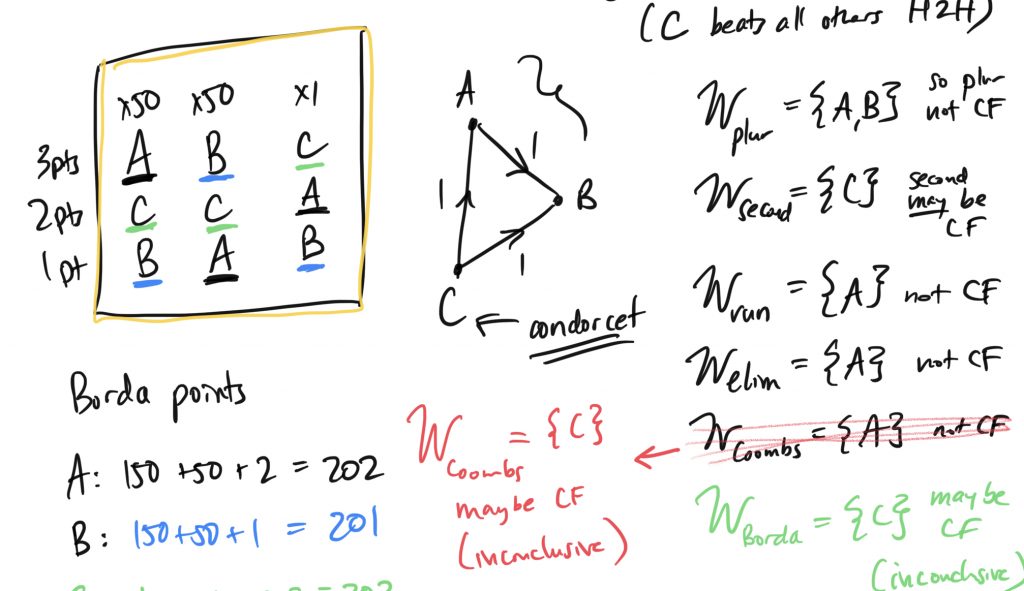Resources
This is where you’ll get materials and external links.
Book
For the first half of the course, we are loosely following Christoph Börgers’s book Mathematics of Social Choice. You should have free access to it in PDF form through Tisch Library (LINK). After you authenticate yourself with your Tufts account, you should be able to follow links for online access.
Lectures
| Week 1 – Ch 1/2 | |
| set, element, subset, proper subset, order, intersection, union | LINK (14 mins) |
| voting system, ballot, preference schedule, plurality, dictatorship, majority-fairness, interchangeable voters | LINK (23 min) |
| runoff, elimination, Borda, PWC, sequential, “secondality,” interchangeable candidates | LINK (37 mins) |
| Week 2 – Ch 1/2 | |
| Condorcet cycles, Condorcet candidates, Condorcet-fairness | LINK (9 mins) |
| unanimity-fairness, and reasoning about when some system properties imply other system properties | LINK (32 mins) |
| when to use examples or counterexamples? how to generalize? what should we demand of our democratic systems? intro to VRA * | LINK (34 mins) |
| Week 3 – Ch 3 | |
| spoilers | LINK (21 mins) |
| can any system be spoiler-proof? are spoilers so bad after all? | LINK (19 mins) |
| Week 4 – Ch 4 | |
| Dominating sets, Smith sets, “strong” candidates | LINK (31 mins) |
| Week 5 – Ch 5-6 | |
| Smithification and “no weak spoilers” | LINK (23 mins) |
| Introducing beatpath | LINK (20 mins) |
| Transitivity and its consequences: beatpath has a winner, no weak spoilers, unanimity-fair | LINK+LINK+LINK (44 mins) |
| Week 6 – Ch 7+ | |
| Favorable and neutral moves, monotonicity and strong monotonicity | LINK (29 mins) |
| Runup to impossibility | LINK (20 mins) |
| Week 7 – Ch 9+ | |
| Proof of an Impossibility Theorem (Müller-Satterthwaite) …with a small live audience of question-askers! | LINK (59 mins) [0-41:20 lecture] [41-end questions] |
| More on strategic voting and Impossibility live audience | LINK (59 mins) |
| Week 8 – summing up our Voting Theory unit | |
| Recap and big picture, plus STV | LINK (56 mins) |
| More STV, plus review | LINK (59 mins) [0-29:40 more on STV] [29:40-end review] |
| More midterm review | LINK (60 mins) |
| Even more midterm review! | LINK (55 mins) |
| Week 9 – Census and apportionment | |
| Intro to census and apportionment | LINK (32 mins) |
| Apportionment and paradoxes | LINK (56 mins) |
| Week 10 – Intro to redistricting | |
| Wrap-up of apportionment, turn to redistricting | LINK (56 mins) |
| Compactness — Polsby-Popper and cut edges | LINK (51 mins) |
| Week 11- Fairness in redistricting | |
| Shapes and fairness | LINK (45 mins) |
| Outcome metrics I: partisan symmetry | LINK (54 mins) |
| Week 12 – More metrics | |
| Outcome metrics II: PS continued, efficiency gap | LINK (37 mins) |
| Why restate the formulas? And how do you put these metrics in context? | LINK (53 mins) |
| Week 13 – Ensemble methods | |
| A bit of final project discussion, then ensemble methods | LINK (65 mins) |
| Comparing redistricting approaches, the current state of play, and the big picture | LINK (73 mins) |
| Final exam prep | |
| Review | LINK (82 mins) |
| “Refresher” | LINK (52 mins) |
Errors
* Lecture on “when to use examples” at around 10:00, I gave the wrong winner for the Coombs method. After B is eliminated, C should win! So this example is inconclusive for whether Coombs is Condorcet-fair.

Thanks to Aira for catching the error!